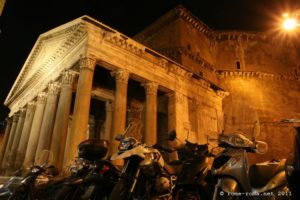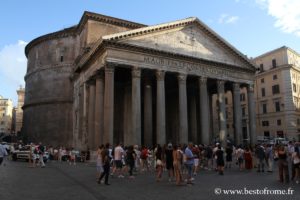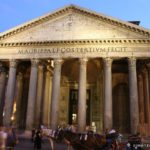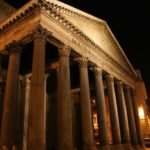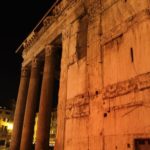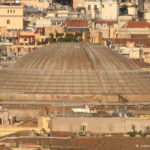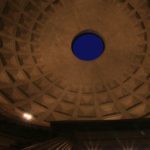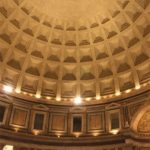In Italian: Pantheon di Roma
The Pantheon of Rome is probably the best-preserved ancient building of Ancient Rome. It was also one of the most prestigious, dedicated to all the gods worshipped by the Romans. The monument is magnificent, with its large circular hall discovered from the inside, an architectural wonder covered by a vast dome with an oculus.
The visit to the Pantheon of Rome is number 3 in our Top 30 sites to see in Rome.
Information, Hours, and Prices for the Pantheon of Rome
Location: Piazza della Rotonda, Roma
Official website: Official Pantheon website
Closed on December 25 and January 1.
Regularly open from 9:00 AM to 7:00 PM, with last entry at 6:30 PM, ticket sales until 6:00 PM.
Full price: €5; Reduced price: €3 (18-25 years old from the EU); Free for those under 18.
Visit Proposals for the Pantheon and Tickets
History and Description of the Pantheon
Once at the back of a large courtyard, the Pantheon is now directly in contact with the street on the beautiful Place de la Rotonde. Originally, it overlooked the area, but now it sits lower due to the elevation of the ground in Rome over time. Indeed, new buildings have accumulated over previous ruins.
History of the Pantheon Since Agrippa
The Pantheon is a temple dedicated to the pagan gods of the Romans, particularly Mars and Venus, who were the protectors of the Gens Iulia (the family of Julius Caesar). It was rebuilt between 118 and 125 AD by Emperor Hadrian to replace the previous temple erected by Agrippa around 27 BC, which burned down in 80 AD. During the final works, the large coffered dome, pierced with an oculus, was raised to a height of 43 meters.
The golden dome symbolised the celestial vault, the residence of the gods of the Pantheon. It could also be interpreted as the image of the universe under the control of Rome.
As with all monuments built under Hadrian’s orders, his name was not inscribed (except for the Temple of Trajan, dedicated to his father). Thus, the frontal porch, formed by sixteen columns, supports a triangular pediment where the following inscription is engraved:
” M. AGRIPPA.L.F.COSTERTIUM.FECIT “
“Made by Marcus Agrippa, son of Lucius, after having been consul three times”
It is unknown how people practiced their worship in the Pantheon, as its structure is very different from other traditional Roman temples.
In the apses of the side aisles of the outer colonnade stood statues of Augustus and Agrippa.
It has survived well over time because it has been in constant use. In 609 AD, it was converted into the Church of Saint Mary of the Martyrs, after it was offered by the Byzantine Emperor Phocas to Pope Boniface IV.
It became the mausoleum of important figures in Italian history, including the tombs of Italian kings Vittorio Emanuele II and Umberto I, and the Renaissance painter Raphael.
Architecture of the Pantheon: Rotunda, Dome, and Pediment
The architecture of the Pantheon was innovative by combining three geometric forms: the circular plan crowned by a dome, the rectangular outer colonnade, and the triangular pediment it supports.
The rotunda of the main body is formed by a series of intersecting arches resting on eight pillars across the entire width of the drum. The dome is supported by a series of horizontally arranged arcades. It holds the record for longevity for this type of construction, lasting more than 18 centuries.
The materials are lighter at the top than at the base. At the bottom are travertine stones, which are the heaviest. Higher up, a mixture of travertine and tuff was used, then a mix of tuff and brick, and finally only bricks in the drum section of the dome, with pumice stone used for the ceiling of the dome.
The interior of the Pantheon of Rome combines tradition and innovation, where the height equals the inner diameter of the dome, at 43 meters.
Originally, it did not have the marble cladding that is present today, which was added long after its construction.
The oculus was an exceptional feat of Roman engineering, and its size was far larger than any other. Since it is still uncovered, rain falls inside and flows along the slightly convex floor, then drained away by the original drainage system.
For Further Reading
- On Wikipedia: The Pantheon on Wikipedia
- On Rome-Roma: The Pantheon of Rome
The Tombs of the Pantheon of Rome
Since the Renaissance, the Pantheon has been used as a mausoleum for prestigious Italian figures. In the exedrae serving as chapels, it houses, in chronological order, the tombs of the painter Raphael (1483-1520), as he wished according to his last will, along with those of his students Baldassarre Peruzzi (1481-1536) and Perin del Vaga (1501-1547).
Next are the tombs of the painters Giovanni da Udine (1487-1564), Taddeo Zuccaro (1529-1566), architect Jacopo Barozzi da Vignola (1507-1573), painter Annibale Carracci (1560-1609), composer Arcangelo Corelli (1653-1713), and the heart of the cardinal diplomat Ercole Consalvi (1757-1824).
Next are the graves of two Italian kings: Victor Emmanuel II (1820-1878) and Humbert I (1844-1900), along with his wife, Queen Marguerite of Savoy (1851-1926).
What to See Around the Pantheon?
When visiting the Pantheon in Rome, you can also explore other nearby sites:
- The Pantheon Square, Piazza della Rotonda, featuring its remarkable fountain and historic buildings.
- Close by is the Piazza della Minerva, home to a Gothic church and Bernini’s elephant sculpture carrying an obelisk.
- Navona Square is a 5-minute walk away, and the Trevi Fountain is a 10-minute walk.
- Discover more about the Pantheon district on rome-roma.net.
Accommodation Selection Near the Pantheon
A selection of hotels, rooms, and apartments near the Pantheon, sorted by price or by distance:
- Good hotels and accommodations sorted BY PRICE within 600 meters of the Pantheon
- Good hotels and accommodations sorted BY DISTANCE from the Pantheon
Photo Gallery of the Pantheon
- Pantheon from Piazza della Rotonda
- Pantheon
- Pantheon
- Pantheon side
- Pantheon front
- Cupola of Pantheon
- Inside the Pantheon, oculus
- Inside the Pantheon
FAQ and Useful Information
How to Reach the Pantheon and Map?
- The Pantheon is located at Piazza della Rotonda in the historic center, accessible on foot from various parts of the city. The nearest bus stop is “Largo di Torre Argentina,” served by several lines, including buses 40, 64, and 87.
Location of the Pantheon on the Rome Map
If you see this after your page is loaded completely, leafletJS files are missing.







